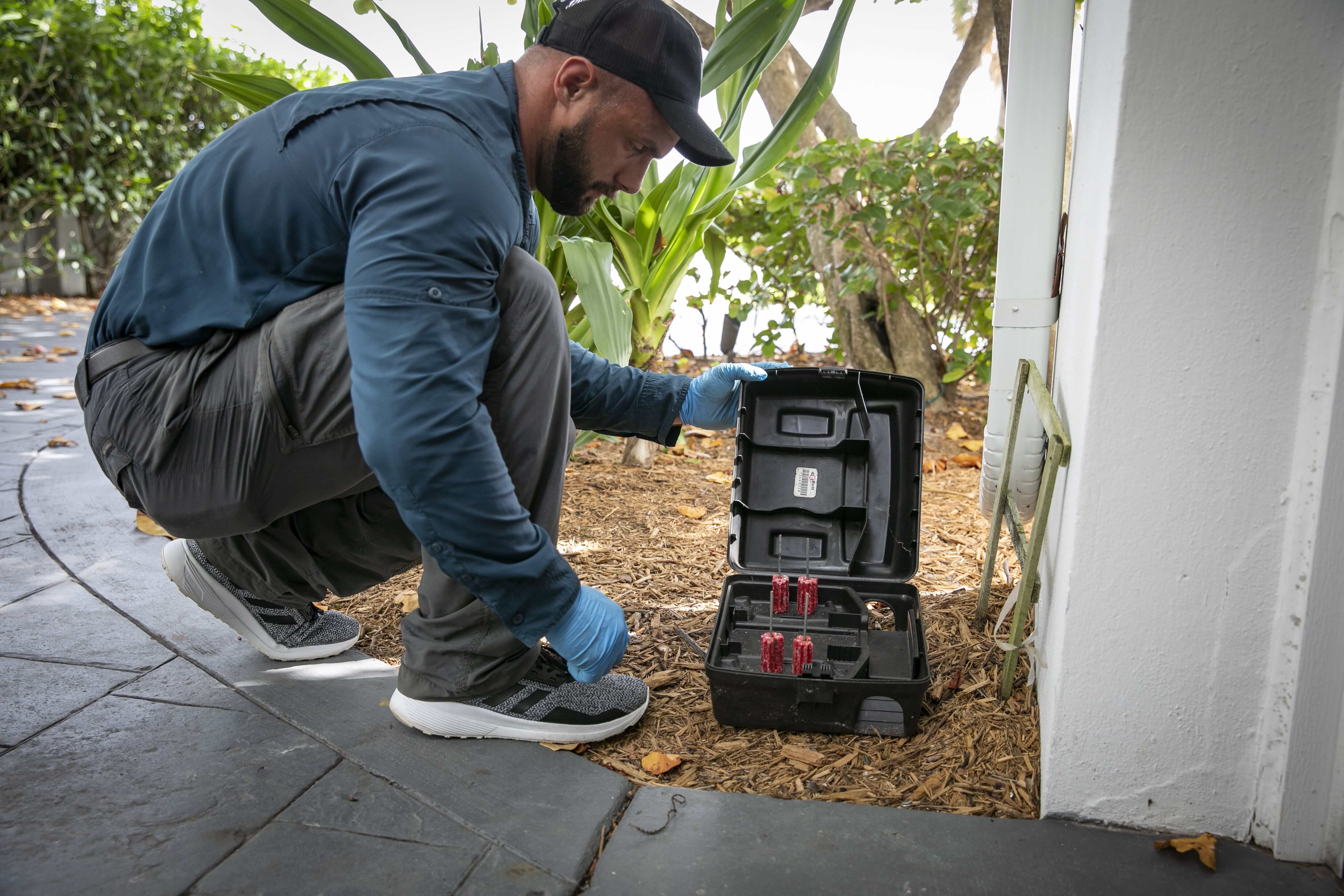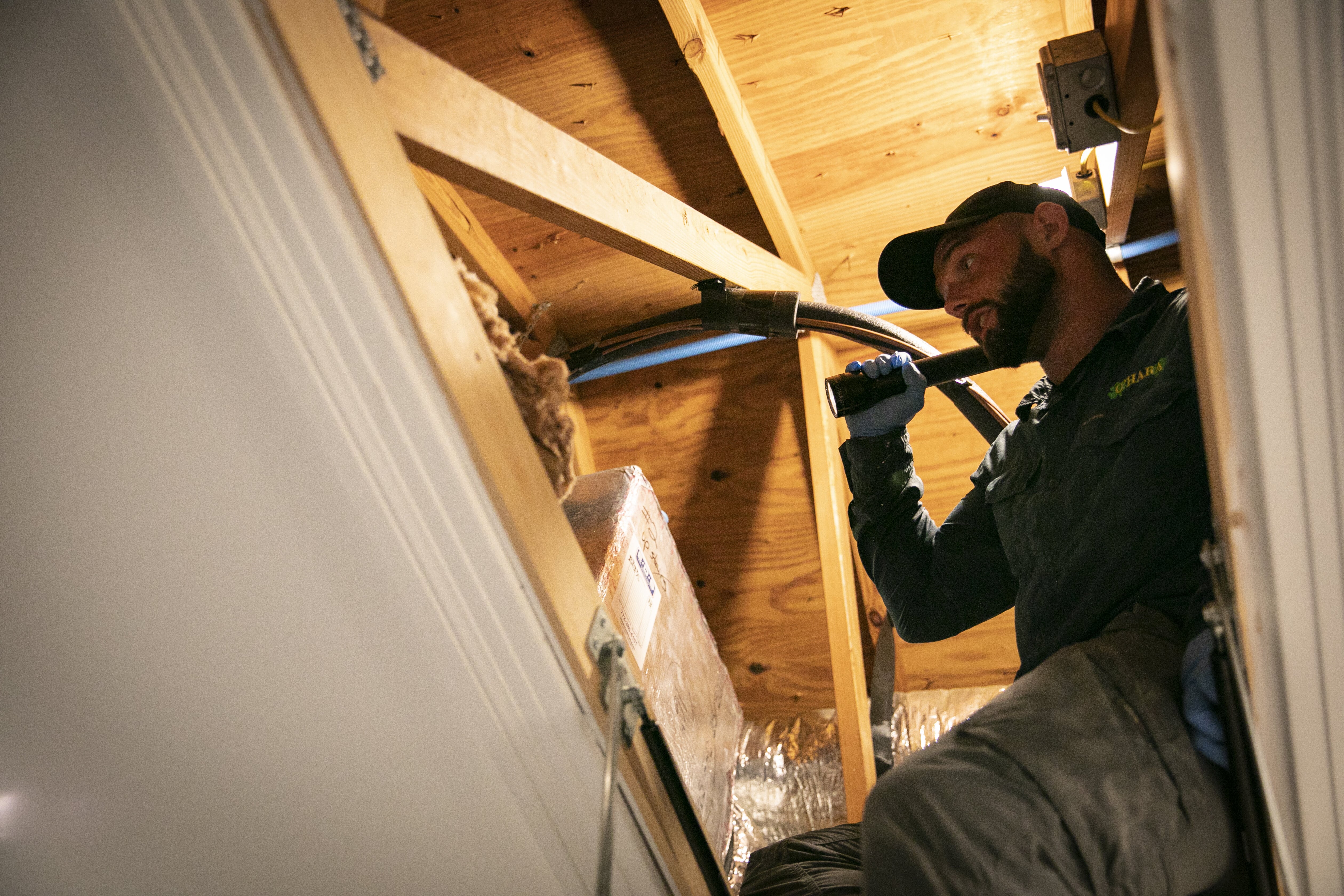Be Aware! Dengue Fever is on the rise in South FL - protect your home against Mosquitos by Scheduling your next spray
Hearing scratching in the attic or spotting a small dropping near the pantry can feel unsettling. If you’ve ever wondered whether one small clue could mean something bigger, you’re not alone.
Acting early makes all the difference. Working with a trusted rat exterminator in West Palm Beach helps homeowners recognize signs before rodents cause expensive damage or health concerns.

Rodents aren’t just an occasional nuisance in South Florida. The warm, humid climate of West Palm Beach gives them everything they need to thrive: food, water, and shelter. Knowing which species you’re up against makes spotting problems easier and helps you respond faster.
Norway rats, often referred to as brown rats, are large, stocky rodents that prefer to nest at ground level. They burrow under foundations, invade basements, and slip in through sewer lines. Their gnawing can cause serious structural issues, and their droppings are much larger than those of mice, making them easier to identify once you know what to look for.
These rats are also strong swimmers. In coastal cities like West Palm Beach, they often travel through drainage systems and emerge in unexpected places. Their resilience makes them one of the most challenging pests to manage.
Roof rats are slimmer and more agile than their Norway cousins. They thrive above ground, often nesting in attics, roof voids, and even trees near homes. They enter through gaps in soffits, roof vents, and overhanging branches. Homeowners often miss early signs of roof rats because these pests stay high and hidden until the colony grows.
What makes roof rats especially troublesome is their preference for fruit, nuts, and garden produce. In areas with citrus trees or backyard gardens, infestations can become chronic without targeted prevention.
Though technically smaller than rats, house mice often spark the same problems. They multiply quickly, slip into the tiniest cracks, and contaminate food supplies. Their droppings are smaller, and their nesting materials often appear as shredded paper or fabric tucked into corners or behind appliances.
Due to their size, many homeowners underestimate the presence of mice. In reality, their ability to squeeze through openings as small as a dime makes them just as destructive as their larger relatives.
Dense vegetation, frequent storms, and a mix of older and newer housing stock create ideal rodent habitats. After heavy rains or hurricanes, rodents are often displaced from their burrows and move into nearby homes. This constant cycle makes vigilance essential for residents. Properties near waterways, golf courses, or lush landscaping face the greatest risk.
Rodents aren’t mindless pests. They’ve adapted to survive in challenging environments, and that intelligence makes them hard to control without the right approach.
Rats remember routes, patterns, and safe zones. If one rat survives a poorly placed trap, the others often learn to avoid it. This makes DIY control frustrating and results in wasted time as colonies expand.
Rodents are most active at night, moving silently through wall voids and attics. By the time you hear them, they may already have a well-established nest. Their ability to use hidden paths keeps them out of sight until damage becomes significant.
Rats and mice are naturally cautious. They notice new objects in their territory and may avoid a fresh trap or bait station for days, sometimes weeks. Homeowners often interpret this hesitation as a failed attempt, not realizing rodents are simply testing their environment.
Rodents aren’t picky eaters. From pet food to pantry snacks, they sample small amounts across multiple locations. This nibbling behavior minimizes their exposure to toxins, which makes poisoning attempts less effective when not handled by experts.
By the time a homeowner sees one rat, dozens may already be present. Rodents reproduce quickly, with litters of six to twelve pups born every few weeks. Without early action, the population curve spikes in a matter of months. What begins as a minor annoyance can quickly escalate into a full-blown infestation before most people realize what’s happening.

Understanding how quickly rodents multiply is key to spotting the problem early. Many homeowners think one rat isn’t a big deal, but that single rodent could be the start of a much larger problem. When you know the stages, you can better gauge when to take action.
Rodents often send out a “scout” to test the area. This individual explores food sources, water availability, and safe nesting spots. At this stage, signs are subtle: a couple of droppings near a food source, faint scratching behind walls, or a single chewed package in the pantry.
It’s easy to dismiss these early warnings, but this is when intervention is most effective. Catching activity at the scout stage prevents nests from being built and colonies from forming.
Once the scout determines the environment is safe, nesting begins. Materials like insulation, shredded paper, or fabric are gathered into a hidden location. Female rats can produce litters of six to twelve pups in as little as three weeks, and these young reach maturity quickly.
Within two months, those pups can begin reproducing on their own. At this stage, the colony is still small, but the foundation for rapid growth has been set. A handful of rodents can turn into dozens in a surprisingly short time.
With one nest established, activity spreads. Rodents recruit new members from surrounding colonies or continue reproducing. They explore further into kitchens, garages, and attics. Homeowners may notice gnaw marks, strong odors, or increased nighttime noises.
Food packaging may be chewed, pet food may vanish overnight, and greasy marks may appear along baseboards. By now, intervention is critical to prevent a full infestation. Waiting only allows the colony to grow stronger and harder to remove.
When numbers swell, the signs become hard to miss. Multiple nests exist throughout the home or property. Droppings accumulate, gnawing causes visible damage, and scratching can be heard at all hours. Strong ammonia odors, greasy smudge marks along walls, and chewed wires or insulation indicate that rodents have made their home.
At this point, professional control becomes necessary to reduce the population. Without expert help, the infestation can persist for years, causing damage to structures and posing a significant health threat.
Rodents are masters at staying out of sight. Spotting them requires looking for clues they leave behind.
Fresh droppings are dark, moist, and soft. Older droppings turn gray and crumbly. In enclosed areas like pantries or attics, you may notice a musky or ammonia-like odor, which is a strong indicator of rodent urine. Even a faint smell that lingers after cleaning could signal a hidden nest nearby.
Rats and mice gnaw constantly to keep their teeth from overgrowing. Fresh gnaw marks appear lighter in color and have sharper edges, while older marks darken. Wooden beams, food containers, and electrical wiring are common targets for theft. Electrical gnawing is especially dangerous, as it can spark house fires.
Scratching, scurrying, and squeaking often come from behind walls, under floors, or above ceilings. These sounds typically increase at night when rodents are most active, but in severe infestations, noises can also be heard during the day. Many homeowners describe the sounds as “footsteps in the ceiling” or “rustling in the pantry.”
Shredded paper, insulation, or fabric stuffed into corners or behind appliances often indicates nesting. Even small accumulations of these materials should raise a red flag. Nests are usually hidden, but if you stumble across one, it often means you’ve uncovered only part of the problem.
Rodents use the same paths repeatedly, leaving behind greasy streaks or rub marks along walls, baseboards, and pipes. These runways are often hidden but can be spotted with careful inspection. Shine a flashlight along baseboards in dark rooms and look for subtle trails.
Norway rats may dig burrows near foundations, landscaping, or sheds. Roof rats often exploit openings near eaves, vents, or rooflines. Any small hole or gap wider than a pencil is a potential entryway. Sealing these gaps quickly can make a big difference in prevention.
Cats and dogs often detect rodents before humans do. If your pet suddenly fixates on a wall, floor, or cabinet, it may be reacting to hidden movement or scent. Paying attention to these signals can provide valuable early warnings.

When it comes to rodents, misinformation spreads almost as fast as the pests themselves. It’s easy to underestimate a problem or try outdated methods that don’t work. Clearing up the most common myths helps you take smarter steps toward keeping your home rodent-free.
Reality: Rats are experts at staying out of sight. They’re nocturnal, cautious, and fast. Most homeowners never see a live rat until the infestation is serious. By the time one scurries across the floor, it usually means a larger population has taken hold.
Instead of looking for the rodents themselves, focus on indirect evidence, such as droppings, odors, and unusual nighttime sounds.
Reality: A single trap may catch a single rat. But that doesn’t solve the root problem. Rodents reproduce quickly, and they learn from each other’s mistakes. If one rat is caught in a trap, the others may avoid it entirely.
Effective trapping requires a strategic approach: using the proper bait, placing it correctly, and rotating it regularly. A serious infestation demands multiple traps, used over time, and combined with other tactics.
Reality: Poison baits can be risky and ineffective when used improperly. Rodents often sample food in small amounts, so they may not ingest a full lethal dose. Worse, poisoned rats may die inside your walls or attic, leaving behind foul odors and sanitation issues.
For families with pets or children, baits can pose additional risks. It’s better to rely on integrated pest management that combines exclusion, trapping, and professional oversight.
Reality: Just because you haven’t found droppings doesn’t mean your home is rodent-free. Droppings may be hidden behind walls, under appliances, or in areas you rarely access.
Some rodents, especially roof rats, tend to reside in the attic or upper levels of the home. Unless you check those spots regularly, the infestation can stay hidden for weeks or months.
Reality: Clean homes can still attract rodents. All it takes is access to food, water, and shelter. A spotless kitchen won’t matter if there’s an open vent in your roof or a crack in your garage door.
Rats are opportunists. They don’t care how clean your home is—they care whether they can find a warm, dry space to nest and something to snack on.
Prevention is always easier (and less expensive) than removal. The good news? A few consistent habits and home improvements can significantly reduce the attractiveness of your space to rats and mice.
Begin by taking a careful walk around your home, both inside and out. Look for cracks in the foundation, gaps around utility lines, missing vent screens, and loose weather stripping. If you can fit a pencil into a gap, a mouse can get through.
Use steel wool, caulk, hardware cloth, or other rodent-resistant materials to block potential entry points. Don’t rely on foam sealants alone—rats can chew right through them.
Rats possess a highly developed sense of smell. Open chip bags, loosely sealed cereal boxes, or bulk pet food can quickly draw them in. Use containers made of thick plastic, glass, or metal for storing dry goods.
The same goes for birdseed, garbage, compost bins, and even pantry staples like rice or flour. Keeping these items tightly sealed removes one of the biggest attractions for rodents.
Rodents love hiding in piles of cardboard, cluttered storage bins, or unsealed trash. Keep storage areas tidy, especially in garages, sheds, and attics. Don’t let garbage pile up near your home’s exterior walls.
If you have firewood, stack it at least 18 inches off the ground and several feet from the house. Avoid allowing vegetation or mulch to build up directly against the foundation.
Leaky pipes, standing water, and humid crawlspaces offer ideal nesting conditions. Repair drips promptly, clear gutters, and run dehumidifiers in areas prone to moisture, such as basements or under sinks.
Rodents need water as much as they need food. Drying out their environment forces them to look elsewhere.
Roof rats often enter homes by running across tree limbs, wires, or vines. If branches hang over your roof or touch the walls, it’s time to prune them back.
Keep a two-foot clearance between vegetation and your house. Also, trim dense shrubs and remove ivy or other clinging plants that provide easy access for climbing.
Even if you don’t think you have rodents, setting a couple of traps in quiet corners (like the attic or behind the refrigerator) can give you peace of mind. If they remain untouched for a few weeks, great. If not, you’ve caught early signs before a larger problem takes root.
Use snap traps over glue traps whenever possible. They’re more humane, and they let you monitor results more clearly.
In West Palm Beach, rat activity can spike after storms or when temperatures shift. After hurricanes or heavy rains, rodents may relocate into homes from flooded burrows.
In the cooler months, they move indoors to seek warmth. Schedule seasonal home inspections to ensure that recent weather hasn’t created new entry points or vulnerabilities.

By the time signs of a rodent infestation become obvious, it’s often beyond the reach of store-bought traps and internet tips. This is where professionals step in. Their role isn’t just to get rid of pests—it’s to investigate, eliminate, and prevent the problem from ever returning.
At the earliest stage, pest control professionals perform a thorough inspection. They look for subtle signs that homeowners may miss, such as smudge marks, insulation trails, droppings in concealed areas, and structural vulnerabilities.
Using flashlights, mirrors, and tracking dust, they identify rodent runways and locate nests. In some cases, infrared cameras or moisture meters help locate activity behind walls. Once the nest is found, they use targeted traps and immediate exclusion to prevent re-entry.
In homes where a scout rat has just arrived or a small nest is forming, prompt action from a professional can prevent the problem from escalating.
As nests multiply, rodents become increasingly difficult to catch. Pest specialists switch to a multi-layered approach. Traps are deployed in high-traffic zones using proven baiting methods, rotated frequently to prevent bait shyness.
Professionals also inspect surrounding structures, such as sheds, garages, and fences, to determine how rats are moving between indoor and outdoor spaces. Every gap larger than a quarter inch is sealed. Any nesting material found is removed, bagged, and disposed of safely.
Behavioral knowledge becomes especially useful here. Professionals know which species they’re dealing with and adjust placement and technique based on the rats’ unique habits.
In larger infestations, one-time removal isn’t enough. Professionals combine aggressive trapping with sanitation, repair work, and monitoring.
They may install tamper-proof bait stations outside the home, designed to intercept rodents before they reach indoor areas. Inside, attic decontamination may be required to remove droppings, urine-soaked insulation, and nests that could attract future rodents.
Follow-up visits are critical. A reliable exterminator won’t just solve the problem and disappear. They’ll return to recheck sealed areas, test for new activity, and adjust the treatment plan as needed.
What separates a professional from a DIY approach is strategy. It’s not just about catching rats—it’s about breaking their access and habit loops.
Professionals understand breeding cycles, identify food and water sources, and know where to find secondary nests. They don’t rely on guesswork. They use training, experience, and data to create a lasting solution.
For homeowners in West Palm Beach, that kind of expertise matters. Our climate, architecture, and storm patterns create constant challenges for rodent control. The right exterminator knows how to navigate these factors and protect your property in the long term.

Whether you’ve heard scratching in the attic or want peace of mind after a nearby rodent sighting, working with a qualified rat exterminator makes all the difference.
Rodents won’t go away on their own. Once they’ve moved in, they adapt quickly, reproduce even faster, and hide in places you’ll rarely check. Acting early means avoiding thousands of dollars in damage, protecting your health, and preventing future infestations.
If you’re ready to take action, our team at O’Hara Pest Control is here to help. We know South Florida homes inside and out—from the smallest kitchen gaps to the biggest attic colonies. Our approach is thorough, professional, and focused on long-term prevention—not just quick fixes.
Call us today to schedule a rodent inspection, and let’s work together to keep your home clean, quiet, and rodent-free.